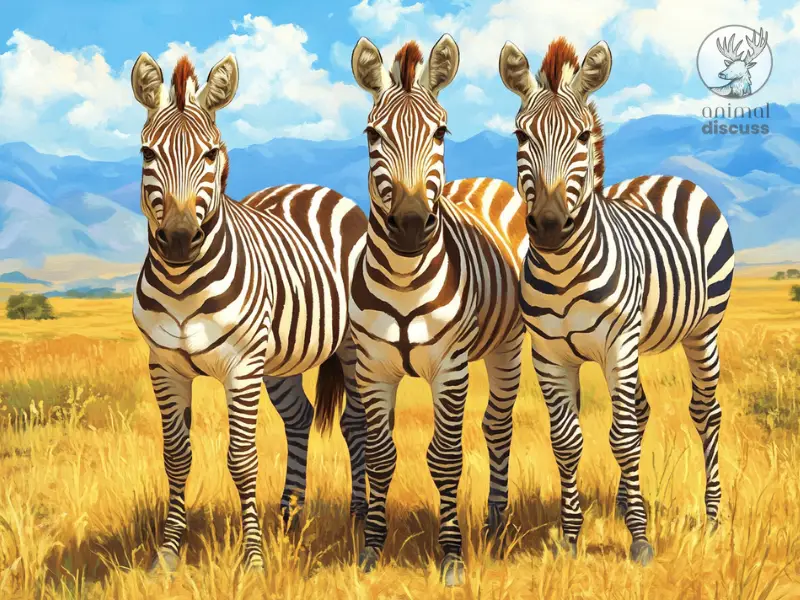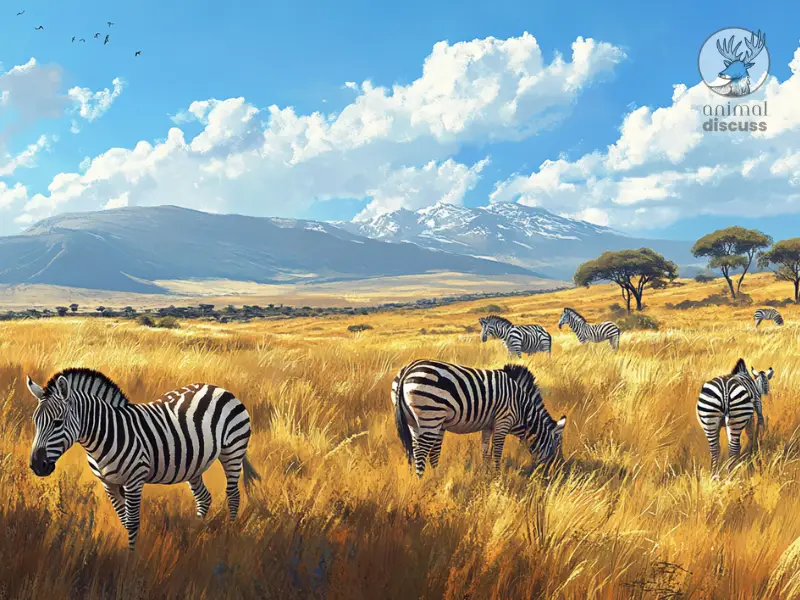Let’s kick things off with the basics: zebras. With their striking black-and-white stripes and close resemblance to horses, zebras have intrigued humans for centuries.
But beyond their unique looks, there’s so much more to understand about these animals.

In this article, I’ll cover everything from their physical characteristics to their behavior, habitat, and why they’re crucial to the African ecosystem. You’ll also learn about the different zebra species and what makes each of them unique.
Ready to dive into the world of zebras? Let’s get started.
To learn more about wild animals and their unique traits, check out our complete wild animal guide.
1. What Are Zebras?
Zebras are wild, herbivorous animals that belong to the Equidae family, which also includes horses and donkeys.
Known for their distinct black-and-white striped coats, zebras are native to Africa and are commonly found in savannas, grasslands, and some mountainous regions.
But what exactly are zebras, and why are they so special?
Zebra Classification
To fully understand zebras, it’s important to look at their classification in the animal kingdom.
Here’s a breakdown of their taxonomy:
| Category | Details |
| Class | Mammalia (Mammals) |
| Order | Perissodactyla (Odd-toed ungulates) |
| Family | Equidae (Horse family) |
| Genus | Equus |
| Species | 3 main species (Plains Zebra, Grevy’s Zebra, Mountain Zebra) |
| Subspecies | Numerous, depending on the species |
Zebras are classified under the genus Equus, which also includes horses and donkeys.

The three primary species of zebras differ in terms of size, habitat, and stripe pattern, which we’ll explore in detail below.
What Do Zebras Look Like?
The most recognizable feature of zebras is their coat of black and white stripes. Contrary to popular belief, zebras actually have black skin under their fur, and the stripes are white overlays on top of their black base.
These stripes serve several purposes, from camouflage to social recognition. We’ll dive deeper into the significance of these stripes later in the article.
Physically, zebras are medium-sized animals, with a shoulder height of around 4 to 5 feet (1.2 to 1.5 meters) and weighing anywhere from 350 to 900 pounds (160 to 410 kilograms), depending on the species.
Their strong, muscular bodies are built for endurance, allowing them to travel long distances in search of food and water.
2. Zebra Species: What Are the Different Types?
There isn’t just one kind of zebra-there are three distinct species, each with its own unique characteristics.
Understanding the differences between these species is key to appreciating the diversity of the zebra family.
The Three Main Zebra Species
Zebras are divided into three main species:
01. Plains Zebra (Equus quagga): The most common zebra species, often seen in large herds across Africa’s savannas and grasslands. They are highly social animals and have broad, bold stripes.
02. Grevy’s Zebra (Equus grevyi): The largest of the zebra species, Grevy’s zebras have narrow stripes and a distinctive white belly. They are found mostly in Kenya and Ethiopia and are classified as endangered.
03. Mountain Zebra (Equus zebra): As their name suggests, mountain zebras live in mountainous regions of southern Africa. They have a dewlap (a flap of skin on their throat) and stripes that stop at the midsection of their bodies.
How Are the Species Different?
Now that you know the species, let’s compare them in terms of size, stripe pattern, habitat, and behavior:
| Species | Size | Stripe Pattern | Habitat | Social Behavior |
| Plains Zebra | Medium-sized (4-5 ft tall, ~700 lbs) | Broad, bold stripes | Savannas and grasslands | Social, live in large herds |
| Grevy’s Zebra | Largest (~900 lbs, ~5 ft tall) | Narrow stripes, white belly | Semi-arid grasslands, Ethiopia and Kenya | Less social, small groups or solitary |
| Mountain Zebra | Smaller (~500 lbs, 4-4.5 ft tall) | Stripes on neck, dewlap present | Mountainous regions in southern Africa | Small family groups |
3. Zebra Stripes: More Than Just Aesthetic
Zebra stripes are one of nature’s most fascinating adaptations.
But what exactly are they for?
Over the years, scientists have proposed several theories to explain the function of zebra stripes, and although we don’t have a definitive answer, each theory offers valuable insights.
Why Do Zebras Have Stripes?
Here are some of the most popular theories:
01. Camouflage: The stripes may help zebras blend into their environment, especially in the dappled light of forests or tall grasses. This makes it harder for predators, such as lions, to single out individual zebras from the herd.
02. Thermal Regulation: Another theory suggests that the alternating black and white stripes help zebras regulate their body temperature. The black stripes absorb heat, while the white stripes reflect it, creating small air currents across the zebra’s body.
03. Social Interaction: Zebras recognize each other by their unique stripe patterns, which helps them bond within their herds.
04. Predator Confusion: When zebras move as a group, their stripes create a visual illusion that confuses predators, making it difficult for them to target a single animal.
While it’s possible that all of these factors play a role, there’s still ongoing research to fully understand the purpose of zebra stripes.
4. Zebra Habitat and Diet: How Zebras Survive in the Wild
Zebras are highly adaptable creatures, capable of thriving in a wide range of environments.
Their ability to live in both grasslands and mountainous regions has helped them spread across much of Africa.
Where Do Zebras Live?
Zebras primarily live in eastern and southern Africa, with different species favoring different habitats:
- Plains Zebras: Found in savannas, open woodlands, and grasslands.
- Grevy’s Zebras: Prefer semi-arid grasslands in Kenya and Ethiopia.
- Mountain Zebras: Live in rocky, mountainous regions in southern Africa.
Zebras are migratory animals and will travel long distances to find food and water, especially during the dry season.
Curious where zebras live? Check out our in-depth article on their natural habitats and survival zones.
What Do Zebras Eat?
As herbivores, zebras primarily feed on grasses.
Their teeth are well-suited for grinding down tough grass, which forms the bulk of their diet.

During the dry season, when grasses are sparse, zebras will also eat leaves, bark, and shrubs.
Zebras have a unique digestive system that allows them to extract nutrients from low-quality food, giving them a survival advantage in areas with scarce vegetation.
Learn more about what zebras eat in our detailed Zebra Foods and Diet guide.
5. Zebra Social Behavior: How Do They Interact?
Zebras are highly social animals.
In the wild, zebras live in groups called herds, which provide them with protection from predators and a sense of community.
How Do Zebras Live in Groups?
Zebra herds are typically made up of one stallion, several mares, and their young.
The stallion is responsible for protecting the group from predators, while the mares care for the foals.
Interestingly, zebra herds often mingle with other species like wildebeests and antelopes.
This multi-species herd offers added protection since each animal has different strengths when it comes to spotting predators.
Communication Among Zebras
Zebras communicate with each other through vocalizations, facial expressions, and body movements.
A zebra’s ears are especially important for signaling their mood: forward ears indicate curiosity, while flattened ears signal aggression or danger.
For a deeper dive into how zebras interact, migrate, feed, and protect themselves, check out our comprehensive guide on zebra behavior. It covers everything from social dynamics to survival strategies in the wild.
6. Natural Predators and Defense Mechanisms
Living in the wild, zebras face numerous predators, including lions, hyenas, leopards, and crocodiles.
However, zebras have developed several defense mechanisms to protect themselves.
Who Hunts Zebras?
Zebras are often preyed upon by large carnivores.
Lions are the most common predators of zebras, but they also face threats from spotted hyenas, leopards, and wild dogs.

Even crocodiles may attack zebras during river crossings.
How Do Zebras Defend Themselves?
Zebras rely on both speed and group tactics to evade predators.
They can run at speeds of up to 65 kilometers per hour (about 40 miles per hour), which helps them outrun most predators.
Additionally, zebras will often stand in a circle with their backs to each other when threatened, using their powerful hind legs to kick at predators.
This makes it difficult for any single predator to attack without risking injury.
7. Zebras and the Ecosystem: Why They’re Crucial
Zebras play a vital role in maintaining the balance of their ecosystem.
Their grazing habits help shape the landscape and provide benefits to other species.
How Do Zebras Impact Their Environment?
Zebras are considered “ecosystem engineers.” By grazing on tough grasses, they keep the vegetation short and encourage new plant growth.
This benefits other herbivores that prefer to feed on shorter, more nutritious grasses.
In addition, zebras help distribute seeds through their droppings, promoting plant diversity in the areas where they live.
Conclusion
Zebras are far more than just their black-and-white stripes. They are social, adaptable creatures that play a crucial role in Africa’s ecosystems.
Whether it’s their unique communication styles, defense mechanisms, or migratory habits, zebras continue to fascinate researchers and animal lovers alike.
Understanding the different species of zebras, their behaviors, and their importance to the environment provides a deeper appreciation for these animals and the challenges they face in the wild.
As we continue to study zebras and their role in nature, it’s clear that these iconic animals will remain a symbol of Africa’s rich wildlife for years to come.
Reference Websites –
- National Geographic – Animals (nationalgeographic.com/animals)
- WWF (World Wildlife Fund) – (worldwildlife.org)
- San Diego Zoo – Animals & Plants (animals.sandiegozoo.org)
- African Wildlife Foundation (awf.org)
- IUCN Red List (iucnredlist.org)

